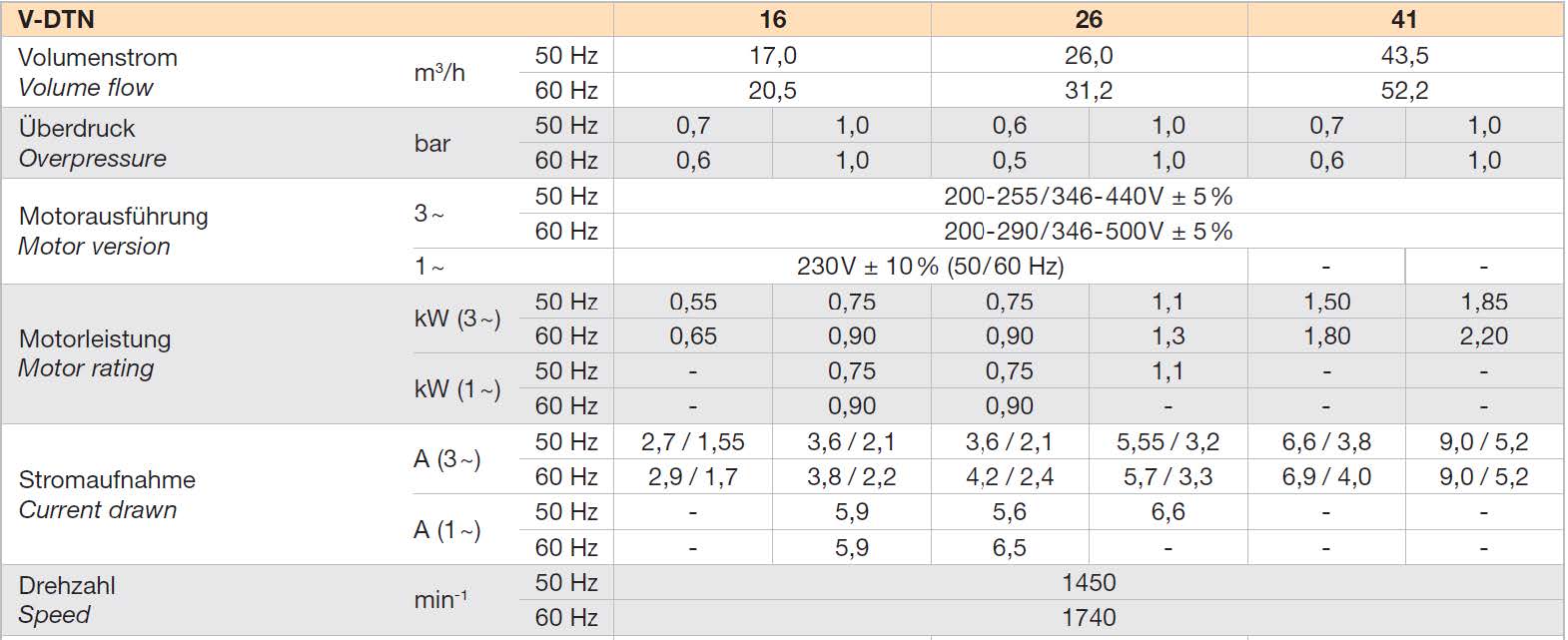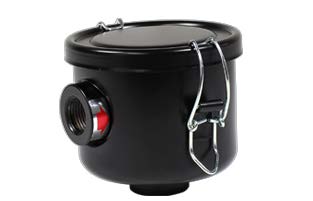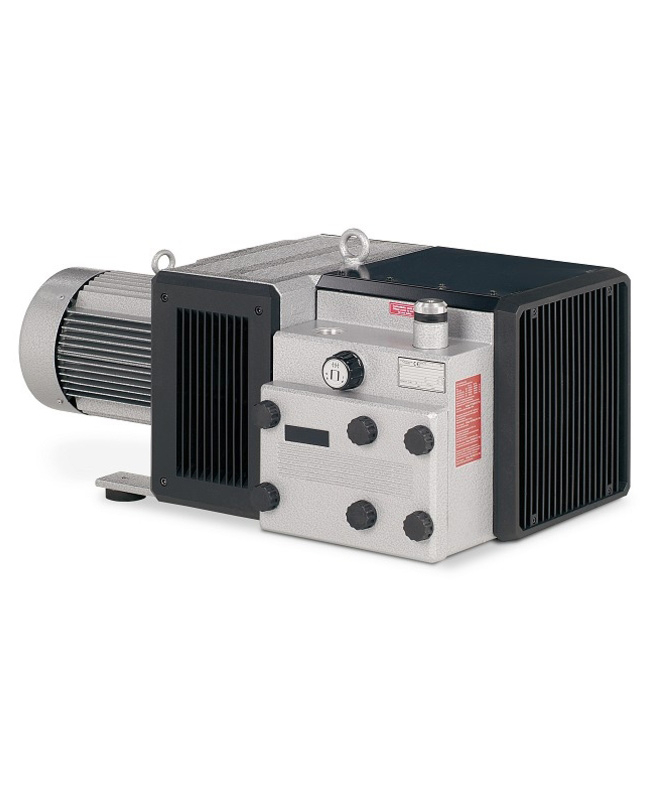
Сухи вакуум помпи с роторни лопатки V-VT серии
Dry Running Rotary Vane vacuum pumps - compressors - pressure/vacuum pumps
- Vacuum up to 150 mbar (abs)
- Pressure up to 1.5 bars (continuous) - 2.2 bars (intermittent)
- Capacity up to 160 m3/h
Our medium size dry pumps are available in vacuum (V-VTN) and pressure (V-DTN). The benefits of the new range are visible at a glance: maintenance and control panels are placed on one side only for easy access to filters and valves.
Low noise and reliability make this series an ideal choice for many OEM applications. Additional features include heat reduction through large cooling air pathways and vents. Design features such as the solid ribs, optimized cooling air circulation, thermal separation of suction and compression chambers within the filter housing, as well as a minimum number of connected heat transferring parts reduce machine temperatures.
Provided in 2 versions:
1. Vacuum pump
2. Compressor
Vacuum pumps




Notes: Capacity at suction conditions at inlet connection, the motors comply with EN 60 034-1 / -2 / -30 (IEC 60034) and thermal class F.
Compressors




Notes: Capacity at suction conditions at inlet connection, the motors comply with EN 60 034-1 / -2 / -30 (IEC 60034) and thermal class F.
Principle of operation
 Pressure increase by volume reduction is the principle behind rotary vane operation. This design offers excellent service in pressure, vacuum or a combination of both. In a cylindrical housing (1) a rotor (2) is positioned eccentrically so that it is on the top almost touching the cylinder. Rotor blades or vanes (4) as they are called, are positioned inside rotor slots (3). When the rotor starts turning, due to centrifugal force the blades are thrown out and slide against the internal surface of the cylinder. In this way a cell (5) is formed between two blades with a volume that changes constantly during rotation. Air enters from the inlet port (6) into a cell until the rear blade reaches the far end of the inlet port (7). At this point the cell (5) has achieved its maximum air volume. As the cell then moves away from the port its volume becomes smaller and smaller, the air is thus compressed and the pressure rises. This continues until the pressure in the cell (8) exceeds that in the pressure chamber (9) and the compressed air then exits through the outlet port (10). Some models are fitted with exhaust valves which stop the backflow of this discharged air if the maximum pressure has been reached. In a vacuum pump the process is similar, but the cell (8) gives decreasing pressure, and the chamber (9) is at atmospheric pressure. With pressure-vacuum pumps the lower end of the inlet port(s) (6) for the vacuum is moved forward. The cell can now be filled through second inlet (11). To avoid impairing the vacuum, this second inlet port is located about one cell segment away from the main suction port. The ratio between vacuum and pressure capacities can be influenced by the choice of inlet port (6 and/or 11).
Pressure increase by volume reduction is the principle behind rotary vane operation. This design offers excellent service in pressure, vacuum or a combination of both. In a cylindrical housing (1) a rotor (2) is positioned eccentrically so that it is on the top almost touching the cylinder. Rotor blades or vanes (4) as they are called, are positioned inside rotor slots (3). When the rotor starts turning, due to centrifugal force the blades are thrown out and slide against the internal surface of the cylinder. In this way a cell (5) is formed between two blades with a volume that changes constantly during rotation. Air enters from the inlet port (6) into a cell until the rear blade reaches the far end of the inlet port (7). At this point the cell (5) has achieved its maximum air volume. As the cell then moves away from the port its volume becomes smaller and smaller, the air is thus compressed and the pressure rises. This continues until the pressure in the cell (8) exceeds that in the pressure chamber (9) and the compressed air then exits through the outlet port (10). Some models are fitted with exhaust valves which stop the backflow of this discharged air if the maximum pressure has been reached. In a vacuum pump the process is similar, but the cell (8) gives decreasing pressure, and the chamber (9) is at atmospheric pressure. With pressure-vacuum pumps the lower end of the inlet port(s) (6) for the vacuum is moved forward. The cell can now be filled through second inlet (11). To avoid impairing the vacuum, this second inlet port is located about one cell segment away from the main suction port. The ratio between vacuum and pressure capacities can be influenced by the choice of inlet port (6 and/or 11).
Technical specifications
Vacuum pumps


High efficiency and silent operation. Sound cover allows a ducted cooling air outlet. Flange mounted IE2 motors with torsionally flexible coupling correspond to DI NEN 60034 and have IP 55 protection and insulation class F. Very low noise level. Corrosion resistant rotors. Hose connection and exhaust silencer as standard.
Compressors


High efficiency and silent operation. Sound cover allows a ducted cooling air outlet (either from one side only or from both front and back). Flange mounted motors correspond to DIN EN 60034 and have IP 55 protection and insulation class F. Hose connector, inlet silencer and pressure relief valve fitted as standard. Can be fitted with compressed air after cooler if required.
Accessories:

Condensate separator: Condensate separator with special separating cartridge for condensate. Fitted with special filter top allowing installation of filter in the vacuum line.
Vacuum tight dust separator: Vacuum tight dust separator complete with paper filter cartridge and special lid, allowing installation of filter in the vacuum line.

Suction filter: comprising of paper filter cartridge encased in a protection cover to be used for the inlet of compressors.
Applications:
Environmental engineering
- Aeration
Industrial applications
- Lifting and holding
- Pick and Place
Packaging industry
Printing Industry
- Post-press applications
- Printing presses
Woodworking industry
- Vacuum hold down
• Low noise level
• Easy to operate
• Dry running, environmentally friendly
• Process safe and reliable
• Robust and economical
• Worldwide service
• Maintenance friendly
Клиенти, които ни се довериха


















